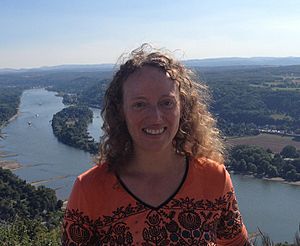Tamar Ziegler facts for kids
Quick facts for kids
Tamar Ziegler
|
|
|---|---|
| תמר ציגלר | |

Ziegler in 2013
|
|
| Citizenship | Israeli |
| Alma mater | The Hebrew University |
| Awards | Erdős Prize (2011) |
| Scientific career | |
| Fields | Ergodic theory, Combinatorics, Number theory |
| Institutions | Hebrew University Technion |
| Thesis | Nonconventional ergodic averages (2003) |
| Doctoral advisor | Hillel Furstenberg |
Tamar Debora Ziegler (Hebrew: תמר ציגלר) is an Israeli mathematician born in 1971. She is well-known for her important work in different areas of mathematics. These areas include ergodic theory, combinatorics, and number theory. She is a top professor of mathematics at the Einstein Institute of Mathematics at the Hebrew University.
Contents
Tamar Ziegler's Journey in Mathematics
Ziegler earned her Ph.D. in Mathematics from the Hebrew University. A Ph.D. is a very advanced university degree. Her main guide for this research was Hillel Furstenberg. Her big research project was called “Non conventional ergodic averages.”
After getting her Ph.D., she spent five years in the United States. During this time, she worked as a "postdoc." This is a research job for people who have just finished their Ph.D. She worked at places like the Ohio State University and the Institute for Advanced Study in Princeton.
From 2007 to 2013, she was a professor at the Technion university. In the fall of 2013, she became a full professor at the Hebrew University.
Helping with Math Journals
Tamar Ziegler also helps with several important math journals. Journals are like magazines where new research is published. She helps decide which new math research gets published. For example, she is an editor for the Journal of the European Mathematical Society. She is also an associate editor for the Annals of Mathematics. She is the main editor for the Israel Journal of Mathematics.
What Tamar Ziegler Studies
Tamar Ziegler's research connects different parts of mathematics. She works where ergodic theory meets other fields. These fields include combinatorics, number theory, algebraic geometry, and theoretical computer science.
- Ergodic theory studies patterns and averages in systems that change over time.
- Combinatorics is about counting and arranging things.
- Number theory is the study of numbers and their properties.
- Algebraic geometry uses algebra to study shapes.
- Theoretical computer science uses math to understand how computers work.
One of her biggest achievements was working with other famous mathematicians. These include Ben Green and Terence Tao. Together, they helped solve a very complex math problem. This problem was about finding patterns in numbers.
She also made other important contributions. She helped extend a famous theorem about prime numbers. This is known as the Green-Tao theorem. She also proved a key idea about something called Gowers norms in geometry.
Awards and Recognition
Tamar Ziegler has received many awards for her work. In 2011, she won the Erdős Prize. This is a special award from the Israel Mathematical Union. In 2015, she received the Bruno memorial award.
In 2013, she was named the European Mathematical Society lecturer of the year. This means she was recognized as a top speaker in mathematics. She was also asked to speak at the International Congress of Mathematicians in 2014. This is a very important global meeting for mathematicians.
From 2016 to 2017, she was a special professor at the MSRI. In 2021, she was chosen to be part of the Academia Europaea. This is a group of top scientists from across Europe.

